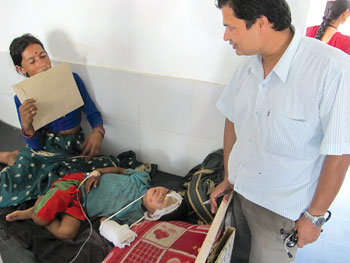A hospital in one of Nepal’s poorest districts that has provided better medical care than hospitals in the capital

PICS: KUNDA DIXIT
PATIENTLY WAITING: Roshan Bista (right) came back to his home district to work as a doctor, and says money can’t buy the fulfilment he gets from working at Bayalpata Hospital.
When need is great and care is first-rate, a hospital can sometimes be too successful.
That could be what is happening to the unique public-private partnership that runs Bayalpata Hospital in remote Achham district. In the past five years, the hospital has provided better medical care than hospitals in the capital in one of Nepal’s poorest districts. For free.
The facility has now become so popular in Achham and surrounding districts that the hospital is overstretched and needs to expand to cope with the sheer volume of patients.
On a recent morning, out-patients were thronging the registration counter waiting for their turn to see doctors. Inside, all 15 beds were full of recovering maternity cases, children who had fallen off kafal trees, those injured in road accidents.
Soon after it was built 30 years ago, equipment at Bayalpata Hospital was dismantled and moved to the district capital of Mangalsen due to political pressure. The people of Sanfebagar requested an NGO working on anti-retroviral treatment of HIV patients to take over the facility and the US-based Nyaya Health set up by three Yale School of Medicine graduates stepped in. The hospital’s annual expenses are about $700,000 a year and nearly all of that comes from individual donors and foundation grants, while the government has been providing $40,000 a year since 2010.
Leading non-profit evaluator GiveWell called Nyaya Health a ‘standout organisation’ last year for its ‘unusual standards of transparency’, a distinction only one per cent of charities evaluated received. Country director Stephen Petersen says Nyaya is lobbying for an increase of annual government contribution to $110,000.
Nearly all the doctors, nurses, and volunteers are Nepali, and most of them are from the far-west. Physician Roshan Bista is from Achham and says he was motivated to give up a city practice to return to his home district. “As a boy I had seen the need for healthcare in Achham and after I became a doctor, I had to see how I could help,” he told us, while doing the ward rounds. “Money can’t buy the sense of fulfilment I get here.”

Volunteer Bhinnata Piya (right) uploads profile of a maternity patient for possible crowdfunding through Kangu.
Bayalpata adheres strictly to its policy of providing free treatment and medicines since most of the 120,000 patients it has treated since 2008 are from ultra poor families. The hospital is now using two crowd-funding partners, Watsi which is used for improving access to specialised surgical care and Kangu to fund safe births. Details of deserving patients, like a child who needs heart surgery in Kathmandu or a mother with a complicated pregnancy, are put up on the sites and overnight pledges pour in from donors around the world.
In the next three years, Bayalpata hopes to reach half of Achham’s population by expanding the hospital as a rural teaching centre and maintaining a network of 38 health and sub-health posts by mobilising a network of 400 female community health workers. In five years, Nyaya Health hopes to have two more hospitals modeled after Bayalpata in Nepal.
We ask Nyaya Health’s Executive Director, Mark Arnoldy if that isn’t too ambitious. He replies: “Ambitious? Yes. Needed? Desperately.”
Kunda Dixit in Achham
Watch the video of Kangu
The Gift of Motherhood from Nyaya Health on Vimeo.
Invest in Nyaya Health’s work in Nepal, visit www.nyayahealth.org/donate
[email protected]
Read also:
Holding up half the district
Free-for-all health care
Resurrection Achham